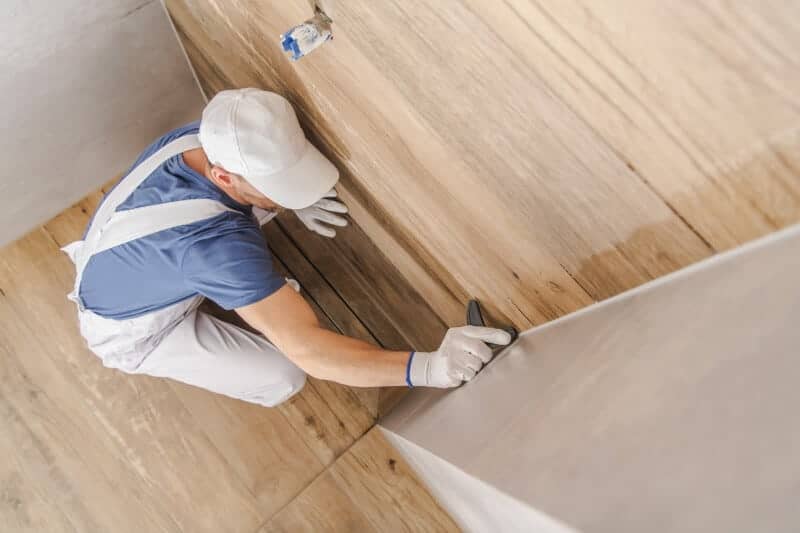Glue and install vinyl flooring correctly
The most important question first:
Floating vinyl flooring or better to glue?
On the basis of our relevant experience, we advise against a floating installation of vinyl flooring in almost all cases.

Many manufacturers of vinyl floors write in their installation guidelines that the floor must not be installed under windows with strong light incidence or rooms with high temperatures.
What has this fact to do with the question “floating or glued installation“?
Most (click) vinyl floors for floating installation are made of solid vinyl, which can deform even at summer temperatures. Under windows with a lot of light, this happens particularly quickly.
This manifests itself in the formation of “hills” (convex deformation) and can push the ground upwards in the middle of the room.
This can cause doors to no longer open (!) or the floor to become irreversibly deformed. In our experience, therefore, in almost all cases floating installation is to be avoided.
If one also considers the Prices for vinyl floors, incl. Laying coststhe floating installation offers no price advantage compared to the much higher quality and more durable glued version.
Laying vinyl floor floating: advantages
- fast installation
- also feasible for laymen
- very cheap for self-publishers
Floating installation of vinyl flooring: disadvantages
- High susceptibility to heat
- Danger of jointing
- Danger of setting up the individual elements
- No price advantage over a (much higher-quality) bonded installation by a service provider
The glue vinyl flooring is not the easiest, but the best way to obtain a stable and durable floor covering. However, the preparatory work must be carried out very precisely so that the vinyl flooring can be perfectly glued to the substrate.
The following methods are available:
- a full-surface bonding by means of adhesive and tooth filler
- gluing with a self-adhesive covering
You can find out right away how vinyl flooring works and what the differences are between the two methods.

Prerequisites for successful bonding
Certain conditions must be met in order to glue a vinyl floor in such a way that it lies evenly on the floor without leaving any marks. This includes a clean, cementitiously filled and smoothly sanded substrate. You can find out how to prepare the substrate perfectly here.
If the subfloor is not perfectly levelled and sanded, the vinyl floor may, in the worst case, have dents or waves after gluing.
Then all the effort was in vain… 🙁
The different types of bonding
1. Full-surface bonding
For full-surface bonding, is applied to the well-prepared substrate with a toothed trowel dispersion adhesive (a wet adhesive), on which the 2 to 4 millimetre thick vinyl planks are then laid.
With the so-called “full-surface gluing“, work is always carried out in paths that correspond to a multiple of the width of a plank. What exactly is meant by this, you can see in the following video.
For this purpose, the wet adhesive is applied to the substrate over a large area over the entire width with precision using a notched trowel and, after allowing the adhesive to flash off briefly, placed in the adhesive bed. When gluing full-surface vinyl flooring, work must be carried out quickly, as the wet adhesive no longer adheres properly after 30 to 40 minutes.
How much adhesive apply?
In addition, neither too much nor too little adhesive should be applied to the substrate to achieve optimum adhesion. If you glue a vinyl floor, you do this with a so-called toothed spatula. These are available in different versions. Depending on the size of the “teeth”, different amounts of adhesive are applied. You can find out exactly which tooth size you need from the manufacturer/dealer of your vinyl floor.
The advantages of a glued vinyl floor
Glued vinyl flooring offers numerous advantages, namely this:
- Solid vinyl is firmly bonded to the substrate, making the floor covering very stable and resistant. This is also the reason why it is used in the shop building as well as in the fair– and event area, among others.
- Even in the case of underfloor heating, the adhesive vinyl flooring is the best solution, as the low installation height and the firm connection of the floor covering to the substrate enable a direct heat transfer.
- A glued vinyl floor satisfies the highest demands and offers good room acoustics.
If you want to have a vinyl floor glued as a tenant, you should first obtain the permission of the landlord in order to be legally on the safe side.
2. Vinyl floor with self-adhesive underside
When bonded with a self-adhesive coating, the back of a module or plank is already prepared with adhesive, which is protected by a film. This is simply removed when the vinyl floor is glued, and the vinyl plank is applied to the previously primed underbody.
This technique, which is used for the vinyl floor ingeste, is popular with do-it-yourselfers, as it requires no skill with adhesive and tooth spatula. Nevertheless, extreme precision is required, o.g. when creating the first rows.
In order to lay a self-adhesive vinyl floor in a first-class manner , not only manual skill is required. It also takes a lot of time. Trained craftsmen can do the work very quickly. You will find one of our craftsman’s workshops also in your vicinity.
Laying of self-adhesive vinyl flooring
Before the vinyl floor can be glued to the already prepared substrate, it should acclimatize around 24 hours before bonding in the publishing room, so that it can adapt to the indoor climate.
Determining the direction of installation
Since the door is the main line of sight into the room, the laying process starts from here. The first step is the most important one, as it determines that the first row and the rows following it are laid exactly.
On the back of the plank there is (usually) an arrow indicating the installation direction.
This direction must be adhered to for all planks. The back slide is pulled off a bit and the first plank is placed exactly at the guide.
Then the rest of the film is removed and the plank is pressed to the floor.
Planks that need to be resized are scored with a sharp knife scored and then bent off. The second row of planks is then arranged at least one third offset from the first row.
For solid vinyl, usually no vinyl cutter or similar tool is necessary.
The holes required for the heating pipes are ideally made with a Forstner drill bit (for floating laid vinyl)
With glued solid vinyl, it is possible to square the holes with a cutter, or carpet knife, and break out. At the end, the skirting boards are screwed to the wall.
This is what we need to glue to the vinyl floor:
- An adhesive spatula
- Adhesive
- A sharp cutter knife or a floor laying knife with trapezoidal blade
- A bevel/angle or metal ruler
- A line strike/chalk line or alternatively a line laser
Measuring the room before sticking
Before laying the vinyl floor, we have to think carefully about where we want to place our first 3-5 rows.
Typically, this is e.g. an exterior wall, which covers the entire length/width of the room.
We should also measure whether our wall of choice is at least reasonably parallel to the opposite wall. If this is not the case, the end result may be that you need to make diagonal cuts that do not look very nice.
In case of doubt, it is better to measure and average a little more.
Cut vinyl floor properly for installation
Vinyl floors can be cut with e.g. a large pair of scissors or a carpet knife. Professionals only scratch the surface with a sharp knife and break off the vinyl plank. This is the fastest way to install vinyl flooring.
Do not apply too much glue
The adhesive has a limited time in which it receives its adhesive strength.
If you wait too long, the adhesive must be laboriously scraped off the floor. It is therefore recommended to mark exactly beforehand how far the adhesive should be applied.
Example:
We want to relocate 5 rows at the same time. Let’s assume a plank has a width of exactly 17 cm. So we draw a marker that is 17 cm x 5 wide (85 cm).
So we apply the adhesive to a track of exactly 85 cm width.
We then lay our first 5 rows of the vinyl floor on the adhesive bed. Then we draw the next 85 cm and so on.
Bonus Tip #1:
After each track that was laid, the flooring should be pressed again.
For this purpose there are, for example, special metal rollers, which are also used for laying carpets. Such rollers can usually be rented from any hardware store.
Alternatively, a board can be wrapped with a towel, with which you can then rub the freshly laid vinyl floor “along“.
Bonus Tip #2:
Even professionals it happens during installation that some adhesive gets onto the vinyl floor.
However, instead of washing it off immediately, it is better to wait until the adhesive has dried.
When washed off, the adhesive only spreads more and is difficult to remove from the joints later. If, on the other hand, it is left to dry, it can usually be removed easily after the vinyl floor has been laid .
Bonus Tip #3
If you need to interrupt the vinyl floor laying for several hours or days, remove excess adhesive from the substrate.
To do this, it is best to take a wooden board with a straight edge and press the excess adhesive flattened on the floor.
This is particularly important in the area of the edges of the vinyl that has already been laid. Otherwise, the glue must be scraped off with a scraper the next day.
Table of Contents



